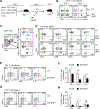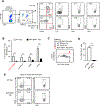Genetically targeting the BATF family transcription factors BATF and BATF3 in the mouse abrogates effector T cell activities and enables long-term heart allograft survival
- PMID: 34599765
- PMCID: PMC8813885
- DOI: 10.1111/ajt.16861
Genetically targeting the BATF family transcription factors BATF and BATF3 in the mouse abrogates effector T cell activities and enables long-term heart allograft survival
Abstract
T cells must be activated and become effectors first before executing allograft rejection, a process that is regulated by diverse signals and transcription factors. In this study, we studied the basic leucine zipper ATF-like transcription factor (BATF) family members in regulating T cell activities in a heart transplant model and found that mice deficient for both BATF and BATF3 (Batf-/- Batf3-/- mice) spontaneously accept the heart allografts long-term without tolerizing therapies. Similarly, adoptive transfer of wild type T cells into Rag1-/- hosts induced prompt rejection of heart and skin allografts, whereas the Batf-/- Batf3-/- T cells failed to do so. Analyses of graft-infiltrating cells showed that Batf-/- Batf3-/- T cells infiltrate the graft but fail to acquire an effector phenotype (CD44high KLRG1+ ). Co-transfer experiments in a T cell receptor transgenic TEa model revealed that the Batf-/- Batf3-/- T cells fail to expand in vivo, retain a quiescent phenotype (CD62L+ CD127+ ), and unable to produce effector cytokines to alloantigen stimulation, which contrasted sharply to that of wild type T cells. Together, our data demonstrate that the BATF and BATF3 are critical regulators of T effector functions, thus making them attractive targets for therapeutic interventions in transplant settings.
Keywords: T cell biology; basic (laboratory) research/science; immunobiology; tolerance: experimental.
© 2021 The American Society of Transplantation and the American Society of Transplant Surgeons.
Conflict of interest statement
Disclosure
The authors of this manuscript have no conflicts of interest to disclose as described by the
Figures






Similar articles
-
BATF and BATF3 deficiency alters CD8+ effector/exhausted T cells balance in skin transplantation.Mol Med. 2024 Jan 31;30(1):16. doi: 10.1186/s10020-024-00792-0. Mol Med. 2024. PMID: 38297190 Free PMC article.
-
Ablation of BATF Alleviates Transplant Rejection via Abrogating the Effector Differentiation and Memory Responses of CD8+ T Cells.Front Immunol. 2022 Apr 19;13:882721. doi: 10.3389/fimmu.2022.882721. eCollection 2022. Front Immunol. 2022. PMID: 35514970 Free PMC article.
-
The activating protein 1 transcription factor basic leucine zipper transcription factor, ATF-like (BATF), regulates lymphocyte- and mast cell-driven immune responses in the setting of allergic asthma.J Allergy Clin Immunol. 2014 Jan;133(1):198-206.e1-9. doi: 10.1016/j.jaci.2013.09.049. Epub 2013 Nov 28. J Allergy Clin Immunol. 2014. PMID: 24290279
-
Specificity through cooperation: BATF-IRF interactions control immune-regulatory networks.Nat Rev Immunol. 2013 Jul;13(7):499-509. doi: 10.1038/nri3470. Epub 2013 Jun 21. Nat Rev Immunol. 2013. PMID: 23787991 Review.
-
The critical role of Bach2 in regulating type 2 chronic airway inflammation.Int Immunol. 2018 Aug 30;30(9):397-402. doi: 10.1093/intimm/dxy020. Int Immunol. 2018. PMID: 29529253 Review.
Cited by
-
BATF and BATF3 deficiency alters CD8+ effector/exhausted T cells balance in skin transplantation.Mol Med. 2024 Jan 31;30(1):16. doi: 10.1186/s10020-024-00792-0. Mol Med. 2024. PMID: 38297190 Free PMC article.
-
METTL3 inhibition reduces N6 -methyladenosine levels and prevents allogeneic CD4+ T-cell responses.Immunol Cell Biol. 2022 Oct;100(9):718-730. doi: 10.1111/imcb.12581. Epub 2022 Sep 17. Immunol Cell Biol. 2022. PMID: 36005900 Free PMC article.
-
BATF alleviates ox-LDL-induced HCAEC injury by regulating SIRT1 expression in coronary heart disease.PLoS One. 2024 Dec 16;19(12):e0306514. doi: 10.1371/journal.pone.0306514. eCollection 2024. PLoS One. 2024. PMID: 39680523 Free PMC article.
-
Characterization of Rationally Designed CRISPR/Cas9-Based DNA Methyltransferases with Distinct Methyltransferase and Gene Silencing Activities in Human Cell Lines and Primary Human T Cells.ACS Synth Biol. 2025 Feb 21;14(2):384-397. doi: 10.1021/acssynbio.4c00569. Epub 2025 Feb 3. ACS Synth Biol. 2025. PMID: 39898483
-
Apex1 safeguards genomic stability to ensure a cytopathic T cell fate in autoimmune disease models.J Clin Invest. 2024 Dec 31;135(4):e183671. doi: 10.1172/JCI183671. J Clin Invest. 2024. PMID: 39739423 Free PMC article.
References
-
- Murphy TL, Tussiwand R, Murphy KM. Specificity through cooperation: BATF-IRF interactions control immune-regulatory networks. Nat Rev Immunol. 2013;13(7):499–509. - PubMed
Publication types
MeSH terms
Substances
Grants and funding
LinkOut - more resources
Full Text Sources
Molecular Biology Databases
Miscellaneous

